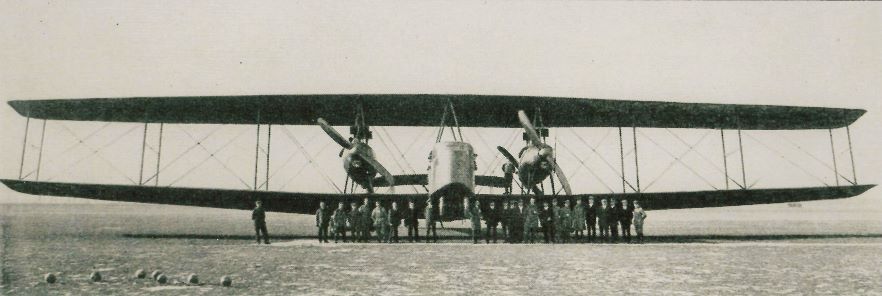ZEPPELINS, GOTHAS & 'GIANTS'
THE STORY OF BRITAIN'S FORGOTTEN BLITZ 1914-1918
29/30 Jan 1918
Bombed: London & Essex
This raid, for the first time, featured only ‘Giants’. Four set out but one returned shortly after take-off with engine problems. Of the other three, the first came inland at the mouth of the Blackwater in Essex at about 10.00pm.
Commanded by Hauptmann Richard von Bentivegni, the leader of Rfa 501, this ‘Giant’ (R.39) headed south-west but at 10.15pm was intercepted by Captain Arthur Dennis, No. 37 Squadron, flying a BE12b. Dennis opened fire as the ‘Giant’ took evasive action while returning fire. After a stoppage, Dennis got his gun working again, emptying the drum of ammunition. But as he loaded another the rough slipstream from the massive aircraft’s engines threw his own out of control. By the time Dennis regained control he had lost sight of R.39. Having thrown off his attacker, von Bentivegni continued on a westward course, being observed from Hertford at 10.56pm. There he turned south, skirting London to the west before commencing to release his bombs on south-western districts of the capital at about 11.30pm. The first of these, 12 incendiaries, fell harmlessly on the open space of Old Deer Park, Richmond. Two HE bombs also dropped here, one in the enclosure of the Kew Observatory and one on the 14th Green of the Mid-Surrey Golf Club. Both dug craters and the Observatory suffered broken windows. R.39 then crossed the north of the Thames and dropped seven incendiaries in and around Syon Park without effect. Next, over Brentford, three HE bombs fell with one in Whitestile Road demolishing a house and claiming the lives of the three women and five children inside. The bomb there, together with one in Enfield Road, badly damaged six other properties and inflicted lesser damage on 151 other houses. At the Metropolitan Water Board’s works at Kew Bridge six HE bombs exploded, killing two men, injuring another and damaging a reservoir, pumping station and boiler house. Another bomb, on the pavement outside the works, caused injuries to five men, burst four water mains, while damaging telegraph and telephone lines and 13 buildings. The final three bombs landed in Chiswick where they caused damage to 99 houses. The crew, way out in their navigation, claimed to have dropped their bombs between Charing Cross and West India Docks on the either side of London. Before R.39 reached the coast, three other RFC pilots engaged her but she escaped.
Giant’ R.26 came inland at 10.44pm over Walton-on-the-Naze in Essex. Taking a south-west course, R.26 progressed only slowly as two of her four engines were giving trouble, then she started to lose height. The crew turned back near Billericay and, flying on only two engines, dropped her entire bomb load at around midnight to gain height. Six HE Bombs dropped at Rawreth, eleven at Rayleigh and one on a farm between Rayleigh and Thundersley. Other than a few broken windows there was no damage. R.26 went back out to sea near Southend at 12.20am.
The last ‘Giant’ to come inland, R.25, crossed the coast near Foulness at 10.50pm and headed west. Picked up by searchlights, a number of British fighters attacked as she followed a course towards London, R.25’s pilots evading as best they could. Near Brentwood at about 11.25pm a bullet put one of her engines out of action but the crew continued with their mission at a reduced speed. The looming appearance of a balloon apron up ahead seems to have finally convinced the crew to turn back and as they did so they released their entire bomb load over Wanstead. All 20 HE bombs landed within 300 yards of each other at Redbridge Lane, most exploding in allotments or on a golf course. This ton of high-explosive caused no injuries, merely breaking a few windows. The crew of R.25 returned home safely but on inspecting their aircraft they discovered 88 bullet holes.
The RFC flew 73 sorties in pursuit of the three ‘Giants’ while the RNAS flew seven. The anti-aircraft guns fired 8,132 rounds. Of those, the guns protecting London fired 3,531 rounds at the two ‘Giants’ that reached the capital.
A R.VI type Riesenflugzeug or 'Giant'
Casualties: 10 killed, 10 injured
Damage: £8,968
Follow Us
© Ian Castle 2021
